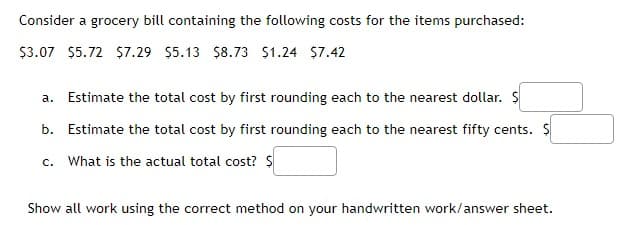Consider a grocery bill containing the following costs for the items purchased: $3.07 $5.72 $7.29 $5.13 $8.73 $1.24 $7.42 a. Estimate the total cost by first rounding each to the nearest dollar. $ b. Estimate the total cost by first rounding each to the nearest fifty cents. S c. What is the actual total cost? $ Show all work using the correct method on your handwritten work/answer sheet.
Consider a grocery bill containing the following costs for the items purchased: $3.07 $5.72 $7.29 $5.13 $8.73 $1.24 $7.42 a. Estimate the total cost by first rounding each to the nearest dollar. $ b. Estimate the total cost by first rounding each to the nearest fifty cents. S c. What is the actual total cost? $ Show all work using the correct method on your handwritten work/answer sheet.
Chapter1: Equations, Inequalities, And Mathematical Modeling
Section1.3: Modeling With Linear Equations
Problem 3ECP: Your family has annual loan payments equal to 28 of its annual income. During theyear, the loan...
Related questions
Question

Transcribed Image Text:Consider a grocery bill containing the following costs for the items purchased:
$3.07 $5.72 $7.29 $5.13 $8.73 $1.24 $7.42
a. Estimate the total cost by first rounding each to the nearest dollar. $
b. Estimate the total cost by first rounding each to the nearest fifty cents. $
c. What is the actual total cost? $
Show all work using the correct method on your handwritten work/answer sheet.
Expert Solution
This question has been solved!
Explore an expertly crafted, step-by-step solution for a thorough understanding of key concepts.
This is a popular solution!
Trending now
This is a popular solution!
Step by step
Solved in 2 steps

Recommended textbooks for you

